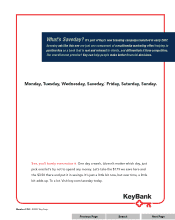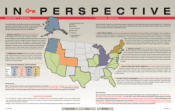KeyBank 2006 Annual Report Download - page 20
Download and view the complete annual report
Please find page 20 of the 2006 KeyBank annual report below. You can navigate through the pages in the report by either clicking on the pages listed below, or by using the keyword search tool below to find specific information within the annual report.
20
MANAGEMENT’S DISCUSSION & ANALYSIS OF FINANCIAL CONDITION & RESULTS OF OPERATIONS KEYCORP AND SUBSIDIARIES
Forward-looking statements are not guarantees of future performance
and should not be relied upon as representing management’s views as of
any subsequent date. We do not assume any obligation to update these
forward-looking statements.
Corporate strategy
The strategy for achieving Key’s long-term goals includes the following
six primary elements:
•Focus on core businesses. We concentrate on businesses that enable
Key to build client relationships. We focus on our “footprint”
operations (i.e., businesses conducted primarily within the states
that have KeyCenters) that serve individuals, small businesses and
middle market companies. In addition, we focus nationwide on
businesses such as commercial real estate lending, investment
management and equipment leasing. We believe Key possesses
resources of the scale necessary to compete nationally in the market
for these services.
•Build relationships. We work to deepen relationships with existing
clients and to build relationships with new clients, particularly those
that have the potential to purchase multiple products and services or
to generate repeat business. To that end, we emphasize deposit
growth across all lines of business. Wealso put considerable effort
into enhancing service quality.
•Enhance our business. Westrive for continuous improvement in
Key’s businesses. We continue to focus on increasing revenues,
controlling expenses and maintaining the credit quality of Key’s
loan portfolios. We will continue to leverage technology to reduce
costs and to achieve these objectives.
•Cultivate a workforce that demonstrates Key’s values and works
together for a common purpose. Key intends to achieve this by:
—attracting, developing and retaining a quality, high-performing and
inclusive workforce;
—developing leadership at all staff and management levels;
—creating a positive, stimulating and entrepreneurial work
environment; and
—paying for performance if achieved in ways that are consistent with
Key’s values.
•Enhance performance measurement. We will continue to refine and
to rely upon performance measurement mechanisms that help ensure
that we are maximizing shareholder returns, that those returns are
appropriate considering the inherent levels of risk involved and that
Key’sincentive compensation plans are commensurate with the
contributions employees make to profitability.
•Manage capital effectively. We will continue to manage Key’s equity
capital effectively through dividends paid to shareholders, through the
repurchase of Key common shares in the open market or through
privately-negotiated transactions, and by investing in our businesses.
Economic overview
In 2006, U.S. economic growth was healthy as measured by the Gross
Domestic Product (“GDP”). GDP growth averaged 3.4% during the
first three quarters of 2006, exceeding the ten-year average of 3.2%. The
nation’s unemployment rate averaged 4.7% during the year, while the
economy created an average of 187,000 new jobs per month. New and
existing home sales declined from record levels in mid-2005, but showed
signs of stabilizing toward the end of the year. Energy prices reached
record highs in July, but subsided substantially by the end of the year.
Despite higher energy costs, personal spending remained robust as
consumers continued to borrow against elevated real estate values. In
an effort to keep inflation from escalating, the Federal Reserve raised
the federal funds target rate from 4.25% to 5.25% during the first six
months of the year. The federal funds target rate has remained at
5.25% since July 2006. Core consumer inflation rose at a 2.5% rate,
exceeding the 2005 rate of 2.2%. In addition, continued domestic and
foreign investor demand for high quality Treasury bonds served to
keep long-term interest rates low, resulting in a relatively flat to inverted
yield curve. The benchmark ten-year Treasury yield began 2006 trading
at 4.37% and finished the year at 4.71%. The two-year Treasury yield
began 2006 at 4.41% and closed the year at 4.81%. During 2006, the
banking industry, including Key, continued to experience commercial and
industrial loan growth.
Critical accounting policies and estimates
Key’s business is dynamic and complex. Consequently, management
must exercise judgment in choosing and applying accounting policies
and methodologies in many areas. These choices areimportant; not only
are they necessary to comply with GAAP, they also reflect management’s
view of the most appropriate manner in which to recordand report
Key’soverall financial performance. All accounting policies are
important, and all policies described in Note 1 (“Summary of Significant
Accounting Policies”), which begins on page 67,should be reviewed for
agreater understanding of how Key’s financial performance is recorded
and reported.
In management’sopinion, some accounting policies are more likely
than others to have a significant effect on Key’s financial results and to
expose those results to potentially greater volatility. These policies apply
to areas of relatively greater business importance, or require management
to exercise judgment, and to make assumptions and estimates that affect
amounts reported in the financial statements. Because these assumptions
and estimates are based on current circumstances, they may change
over time or prove to be inaccurate.
Key relies heavily on the use of judgment, assumptions and estimates in
anumber of important areas, including accounting for the allowance
for loan losses; loan securitizations; contingent liabilities, guarantees
and income taxes; derivatives and related hedging activities; principal
investments; goodwill; and pension and other postretirement obligations.
Abrief discussion of each of these areas follows.
Previous Page
Search
Next Page
Contents
























